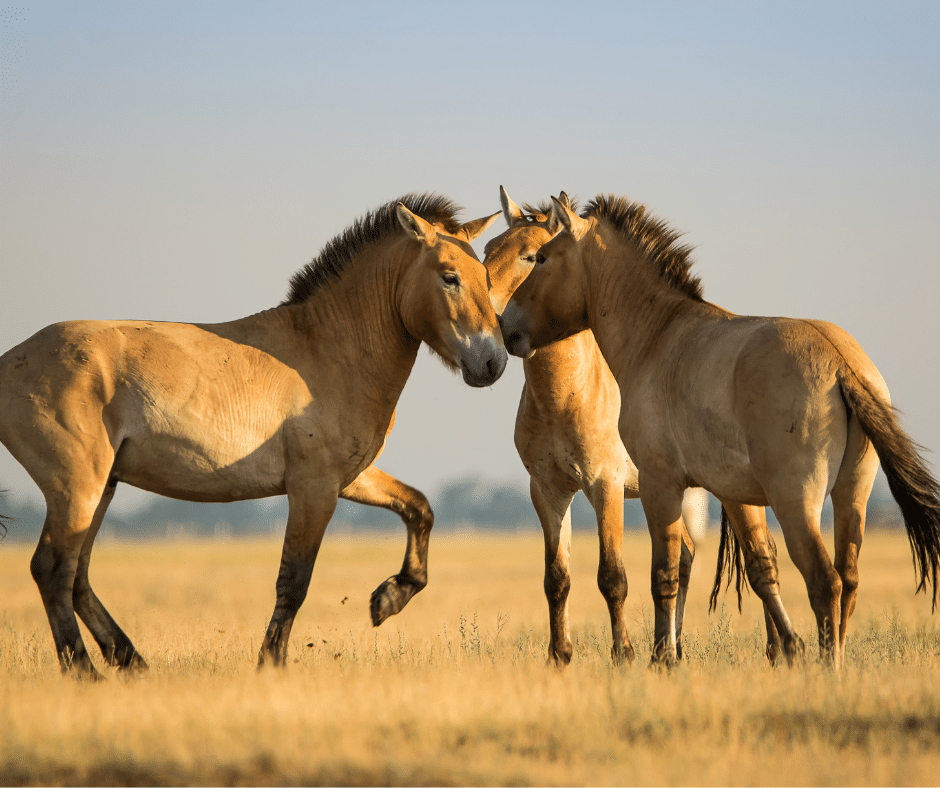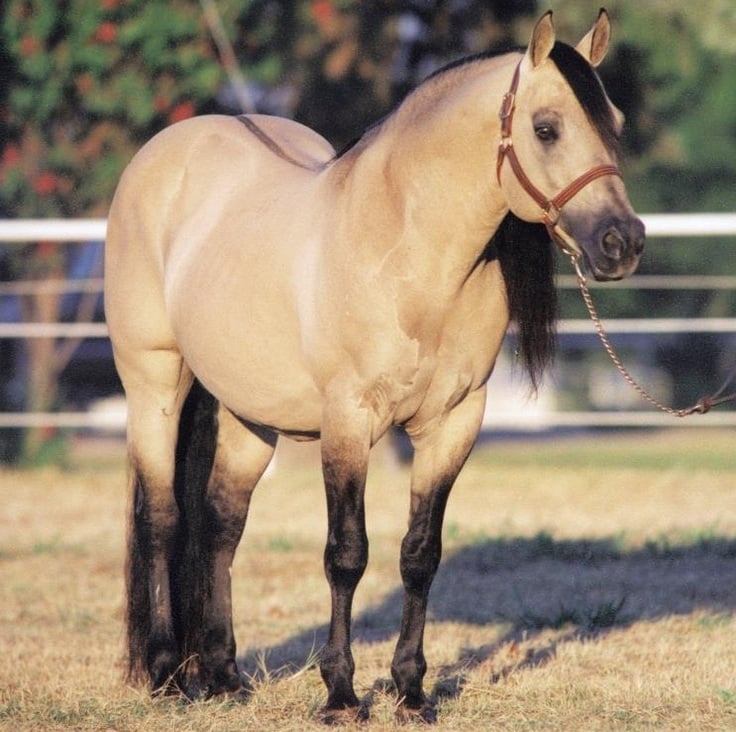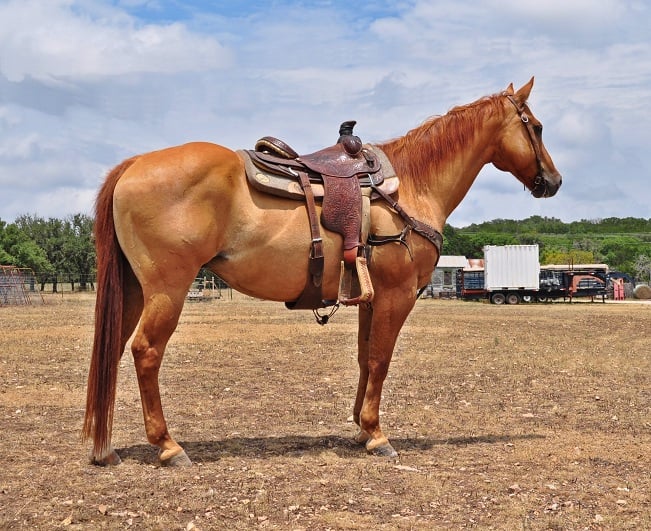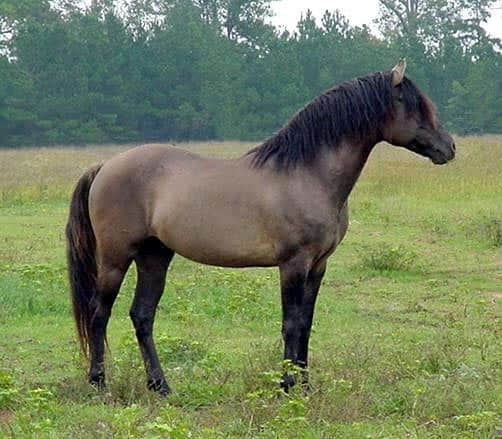What is a Dun Horse?
Many people think that a dun horse is just a buckskin horse with different markings. It can even be easy to sometimes mistake a dun horse for a buckskin because they do have some similarities. Dun horses have certain characteristics that make them unique on their own. Keep reading to learn more about the dun horse.
Are Dun Horses the Oldest Horse?
The dun horse coloration is known to be an old one. Dun horses date back to some of the first known recorded species of horses. If you take a look at prehistoric equine paintings, a lot of the horses pictured are dun, or display characteristics of dun horses. Some of the most popular prehistoric equine paintings that feature dun horses are from the archives of the Chauvet Cave.

Also included in the ancient paintings are the last known wild horse breed that is now currently endangered, the Przewalski horse breed. These horses possess the dun dilution gene and display dun markings.
Dun vs. Buckskin Horse: What’s the Difference?
Buckskin horses and dun horses may look similar in some circumstances, but they’re completely different.
You may be interested in reading more about buckskins here: Everything You Need to Know About Buckskin Horses
Here are a few main distinctions to note between the two:
Markings
The marking of a dun horse is most commonly displayed with primitive markings,a dorsal stripe, and a shoulder stripe. Duns also often have markings on their lower legs, and around their face. In contrast, buckskin horses are defined by the dark points on their coat. In most cases, buckskin horses have dark points on their legs, mane and tail.
Genetics
Although both buckskin horses and dun horses appear because of genetic traits, the genetic processes that cause variations are different.
Buckskin horses are created with a cream dilution gene that appears ONLY in a bay base coat color. Bay horses have a genetic composition that naturally causes darker points on their body, and a brownish coat color. When the cream dilution gene appears, it causes their base coat color to lighten to the true buckskin shade, and the darker points stay in-tact.
On the other hand, dun horses are created with a dun dilution gene that can appear on any base coat color. Yes, this includes black horses! Black horses that possess the dun dilution gene are known as grullo or grulla dun horses.
Hairs
It’s usually not able to be seen by the naked eye, but dun horses can easily be set apart from buckskin based on the pigmentation of their hairs. The diluted hairs on a dun horse do not contain even pigment all the way throughout. This means that on each strand of diluted hair, one side is very deeply pigmented, while the other side will have little to no pigment. This uneven pigmentation in the hair strands is a trait that is completely unique to dun horses. If you’re really up for it, grab a magnifying glass and see if you can spot it!
But Wait… What’s a Dunskin Horse?
Now that we covered the differences between dun and buckskin horses, you should know that it’s possible for the two to merge. When this occurs, it’s from a combination of buckskin and bay dun. A dunskin horse will have a light coat color and the distinctive black points of a buckskin horse. However, the primitive markings that appear only on a dun horse will also be present. In the creation of dunskin horses, both the dun dilution gene and the cream dilution gene are present.
Types of Dun Horses
A “classic” dun horse is the bay dun horse. These horses are the most common type of duns. The bay dun is the coloring that is most often confused with buckskin horses - and rightfully so. The shade of a bay dun is very close to what we know as a standard buckskin. Bay duns are also called yellow duns on occasion, and their coat colors can range from a soft yellow to a gold.
Red Dun Horse
Also known as claybanks, red dun horses are most commonly a light chestnut color. The shade in red duns ranges from light chestnut to a dark red color. In red duns, their markings are not black like with other color variations of dun horses. Rather, their dun characteristics will show up in shades of red.
Black Dun Horse
Black duns, also known as grullo/grulla horses, or blue dun horses, range in shades from silver all the way to black. In black duns, the dorsal markings are black and the face and legs of the horse will be darker than their coat color. The black dun horse is considered to be the most rare type of dun horse.
Dun Horse Names
Horse owners can have a lot of fun when it comes to exploring dun horse names. Because they are so unique in appearance, it’s only fitting that dun horses have a great name to match! If you own a dun horse or you’re considering owning a dun horse and stumped on the name, here are some of the most common names seen across duns:
-
Sandy
-
Honey
-
Toffee
-
Cookie
-
Smoky
-
Mocha
-
Biscuit
-
Peanut
-
Silver
-
Brownie
-
Caramel
-
Henna
-
Graham
-
Dunny
-
Toffee
-
Sahara
Famous Dun Horses
There are many dun horses that have made their mark throughout equine history.
Doc Bar - Inducted into the AQHA Hall of Fame in 1993
Doc Bar started a revolution in the industry. Although he was originally bred to run, it was quickly determined that running was not Doc Bar’s strong suit. Rather, throughout the years Doc Bar developed into a champion halter horse. Doc Bar’s most notable achievements however may have been his offspring. Doc Bar sired National Cutting Horse Association Futurity winners, world champions, and top-10 horses including Doc O’Lena. Doc Bar passed away in 1992.
Doc O’Lena - Inducted into the AQHA Hall of Fame in 1977
Doc O’Lena was the offspring of Doc Bar and he was born in 1967. Doc O’Lena was trained by Shorty Freeman of Arizona. O’Lena and Shorty made quite the dynamic duo. In 1970, the team became the first competitors to ever dominate the preliminaries, sem-finals, and finals at the National Cutting Horse Association Futurity. Doc O’Lena went on to have a very successful career, and sired over 1,300 foals. Of the foals, many accumulated points, earned performance awards, and became world champions. Doc O’Lena was syndicated for over $2 million and passed away in 1993.
Zippos Mr. Good Bar - Inducted into the AQHA Hall of Fame in 2019
A beautiful red dun horse, Zippos Mr. Good Bar was a star show horse and excelled as a sire. As an athletic horse himself, Zippos Mr. Good Bar sired 89 point earners. The earners in his offspring have totalled over 67,000 points, over $3 million in earnings, and over 20 world championships. The most famous of Zippos Mr. Good Bar’s offspring is notably his daughter, Vital Signs are good. Affectionately known by her owners as “Lucy”, the horse won 13 AQHA world championships, 8 world reserve championships, 8 Superiors, and totaled over 3,000 personal AQHA points in her lifetime.
You may also be interested in reading: The Top 7 Greatest Racehorses in History
Are Dun Horses a Good Horse to Own?
Dun horses are certainly pretty to look at, but the dun dilution gene appearing in a horse has nothing to do with whether or not a horse will be a good fit. Rather, when it comes to choosing a horse that is the best fit for you, new horse owners should look at other factors such as breed, temperament, age, and athletic abilities. If you have never owned a horse before, you may be interested in reading our Ultimate Guide for Beginner Horse Owners.
FAQ
What are the breeds of dun horses?
A dun horse is not a breed, but rather a coat color. The dun dilution gene can be found across many horse breeds but it is the most common in heavy pony breeds including Shetlands, Icelandic horses, and Fjord horses. Even though the dun dilution gene can show up throughout all breeds, it’s very rare to see a dun in any Thoroughbred, Arabian, or draft breeds.
What is a lineback dun horse?
A lineback dun horse is just another name for a dun horse, as dun horses are characterized by their dorsal stripe down their back.
Are zebras dun horses?
Horses and zebras share a lot of the same genetic makeup - specifically dun horses. Both dun horses and zebras alike have a dilution gene that causes primitive markings, although zebras have a bit more extreme case.
Are dun horses rare?
No, the dun dilution gene is common across many different breeds of horses.




